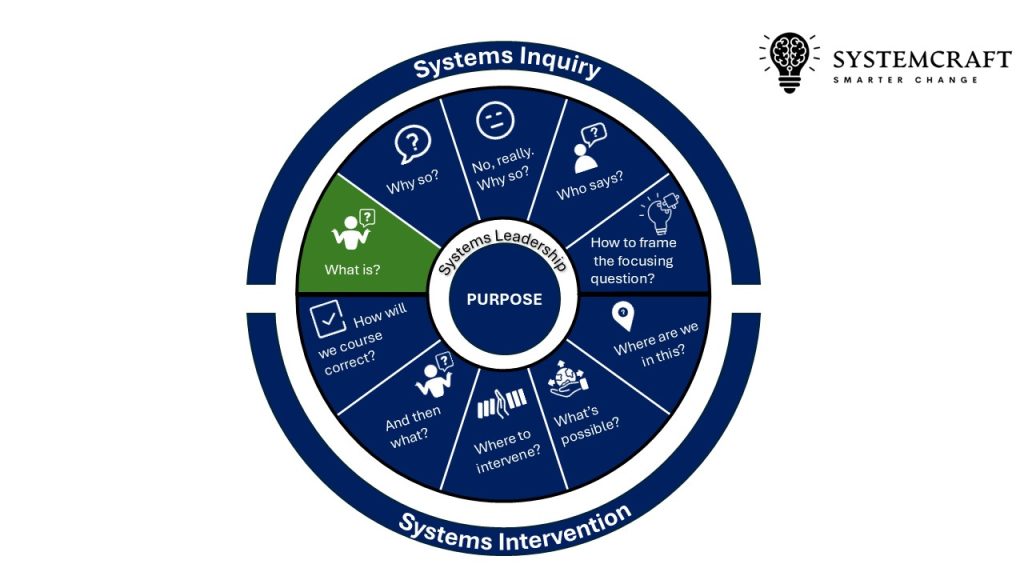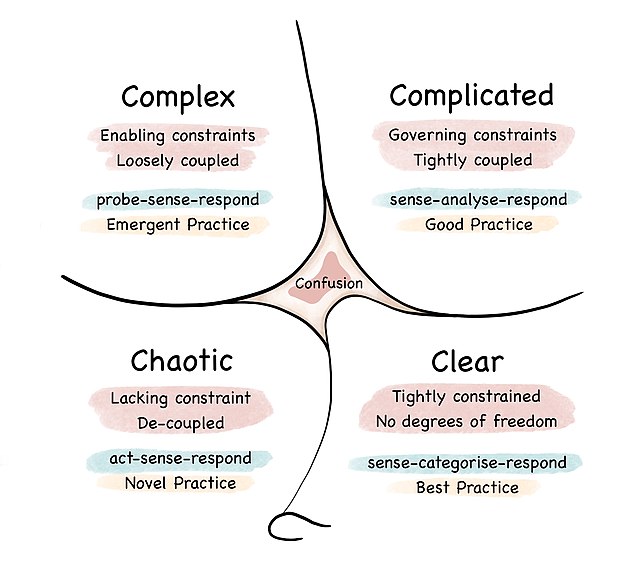7 What is?

Figure 3. Systemcraft – What is? Joyner, K. (2025)
Identifying the issue or problem and making the case for how to place it in its system.
The ‘What is?’ question, while seemingly obvious, is a critical yet often overlooked step in systems change. This question, central to the Systems Inquiry phase of Systemcraft, encourages methodical reflection on the issue thought to be a problem.
Through this questioning, we aim to identify what Michael Jackson (2019) refers to as the System in Focus; the specific system or part of the system that becomes the central point of analysis. Jackson argues that how we define the system in focus directly influences the scope of inquiry and the choice of tools or approaches for tackling the problem. In Systemcraft this concept is essential to building a deep understanding of the issue.
At this stage we also want to consider what kind of problem the system represents. For this inquiry we use the Cynefin model of David Snowden (2002).
Where is the boundary? The System in Focus
As an initial step in Systems Inquiry, the focus is on how we define, frame, or place boundaries around the presenting problem. Later questions, such as ‘Why so?’ or ‘No, really—why so?’ help further explore these boundaries. However, at the ‘What is?’ stage, the aim is often to invite the group to consider the phenomenon of interest to them and question whether the system in focus is the most appropriate one for the inquiry. This concept is crucial because systems are interconnected, and what is considered ‘the system’ depends on the purpose of the inquiry and the perspectives of those involved.
Examples
The presenting problem might be road congestion in one part of the city. This could be a valid and purposeful system in focus. However, through boundary questioning, the group might decide to broaden the scope to consider the city’s entire road network. While some participants may want to go even further and address the entire urban mobility ecosystem, the discussion can help focus on what is feasible with the resources and information available.
What kind of problem is this?
Once the group has agreed on their system in focus, a valuable next step is to consider the nature of the problem. This is a consideration of both scale and complexity.
Small world and grand world problems
In the Introduction we introduced three personas of systems thinkers: The system gamer, the manager as ‘pool-player’ and Angela Merkel. They all demonstrated systems thinking skills. However, the system gamer and even the pool player have what philosopher Savage (1954) would call 'small-world problems.' They still have to consider the dynamics of their whole system but can assess the probability of the consequences of their actions or interventions with some accuracy. Silver describes these as ‘tractable puzzles with relatively well-defined parameters’ (p343). In the Cynefin (2002) framework these would be in the ‘ordered’ domains, either simple, or complicated.
In contrast Angela Merkel, in her role as Chancellor of Germany and a leader within the European Union was working on ‘grand world problems.’ That is, leaders in these contexts experience ambiguity, deep uncertainty and the reality of emerging events that cannot possible be foreseen. The assumptions required for rational decision-making, that is complete knowledge of options and outcomes, break down. We are in the ‘complex’ domain of the Cynefin model (Snowden, 2002).
Savage (1954) expressed concern that decision-makers often misapply small-world reasoning to grand-world problems, leading to overconfidence and misplaced precision. He suggested that when facing grand-world problems, decision-makers may need to rely on heuristics, qualitative reasoning, and adaptive learning rather than rigid utility-maximising calculations.
Applying Dave Snowden’s model (2002).
The Cynefin framework provides a lens for understanding the nature of the system or environment the problem inhabits. By considering the problem against one of Cynefin’s five domains, clear, complicated, complex, chaotic, or aporetic (confused), your group can better grasp the dynamics at play and the type of response needed.

Figure 3.1 Cynefin Framework. Snowden (2002). (“The Cynefin framework. Four types of systems” by Tom@thomasbcox.com is licensed under CC BY-SA 4.0)
The clear domain represents systems with straightforward cause-and-effect relationships, where best practices are well-established, and solutions are evident. The complicated domain involves systems where there is a cause-and-effect relationship, but expertise is required to identify it. In this domain, applying good practices or relying on analysis by experts can lead to solutions.
The complex domain reflects systems where cause and effect can only be understood in retrospect. Here, patterns emerge from interactions within the system, and experimenting, learning, and adapting are essential to finding effective responses. The chaotic domain describes situations with no apparent relationships between cause and effect, requiring urgent action to stabilise the environment before exploring potential solutions. Finally, the aporetic domain reflects uncertainty or situations where decision-makers must embrace doubt, ambiguity, and exploration to navigate the system effectively.
Examples
Returning to our example of road congestion, the group may initially categorise the problem as belonging to the complicated domain, where expert analysis and good practices can help find solutions such as optimising traffic signals or redesigning road layouts. However, broadening the focus to the entire road network might reveal a complex adaptive system, where traffic patterns emerge unpredictably from the countless individual decisions of drivers and commuters. Addressing such a complex system requires experimentation, like piloting congestion charges or encouraging alternative modes of transport, to see how the system responds and adapts.
It is also possible for problems to inhabit more than one Cynefin domain simultaneously, or to transition between domains over time. For instance, an initially chaotic traffic incident, such as a multi-vehicle accident, may require urgent stabilisation measures before evolving into a complex problem as authorities and stakeholders analyse and adapt traffic management strategies. Similarly, parts of a problem may reside in different domains; while optimising traffic signals may be a complicated task, understanding commuter behaviours might require addressing the issue as a complex system. Recognising these overlaps and transitions can provide valuable insights and help tailor responses more effectively.
Key Takeaways
Reference
A decision context where the set of possible states, actions, and consequences can be explicitly defined and probabilistically assessed
Cognitive shortcuts or rules of thumb that simplify decision-making and problem-solving. They help individuals make quick judgments with limited information but can sometimes lead to biases or errors.
An iterative process enabling continuous learning and adaptation in uncertain and dynamic environments.
A dynamic network of interconnected elements that interact and adapt to changes in their environment. These systems exhibit emergent behaviours, self-organisation, and the capacity to learn or evolve over time, making them unpredictable and highly responsive to external and internal influences. Examples include ecosystems, economies, and social systems.

